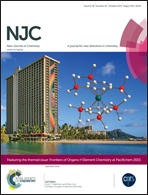Rational design of organoboron heteroarene derivatives as luminescent and charge transport materials for organic light-emitting diodes†
Abstract
A series of organoboron heteroarene derivatives have been designed for applications in organic light-emitting diodes (OLEDs). Their optical, electronic, and charge transport properties have been explored theoretically by using density functional theory (DFT) and time-dependent DFT (TD-DFT). The frontier molecular orbitals (FMOs) and local density of states analysis have turned out that the vertical electronic transitions of absorption and emission are characterized as intramolecular charge transfer (ICT). The calculated results show that their optical, electronic, and charge transport properties are affected by the different heteroaromatic groups. Our results reveal that the molecules under investigation can serve as luminescent materials for OLEDs. In addition, molecules under investigation are expected to be promising candidates for hole and/or electron transport materials. We have also predicted the mobility of the studied compounds. On the basis of investigated results, we proposed a rational method for the design of luminescent materials as well as charge transport materials simultaneously for OLEDs.


 Please wait while we load your content...
Please wait while we load your content...